Universal optical cables GERDA-KOU are designed for digital communication signal transmission when installed in trunk, intra-zone, and local communication lines, as well as for connecting electronic devices with the capability of simultaneously using digital and analog signals.
The application scope and structural features of the cables are presented in Table 1.
Various types of single-mode and multimode optical fibers are used in the cables in accordance with GOST 52266-2020 (see Table 2).
The tight buffer coating of the optical fiber ensures fiber strength, acts as a damping element (absorbing shocks), and provides additional protection from environmental influences. The characteristics of optical fiber in a tight buffer coating are given in Table 3.
The cables are manufactured in modular, tubular constructions and as optical patch cords.
The number of optical fibers in modular-structured cables ranges from 2 to 144, while in cables with a central modular tube and optical patch cords, it ranges from 2 to 12.
The coloring of optical fibers and optical modules ensures their unambiguous identification during installation (see Table 4).
The GERDA-KOU cable can be manufactured in a combined version, where both electrical power (via conductive cores) and optical signals (via optical fibers) are transmitted within the same cable. Optical fibers can be combined with any cable from the “Gerda Cable System.” Using a combined transmission cable reduces costs associated with cable installation.
The fire safety rating and operating temperature of the cables, depending on the sheath material, are provided in Table 5.
The conventional designation of GERDA-KOU cable brands is given in Table 6.
An example of the conventional designation of cable brands for ordering is provided in Table 7.
| Name | Description | Images |
| GERDA-KOU | The cable is designed for suspension on communication line supports, for installation in special (protective plastic) pipes, inside buildings and structures. The number of optical fibers in the cable is up to 144. Resistance to static tensile forces – at least 1.5 kN. Resistance to compressive forces – at least 3.0 kN/100 mm. |  |
| GERDA-KOU-K | The cable is designed for installation in soils of groups 1-3, cable ducts, tunnels, collectors, blocks, inside buildings and structures. The number of optical fibers in the cable is up to 144. Resistance to static tensile forces – at least 2.5 kN. Resistance to compressive forces – at least 4.0 kN/100 mm. | 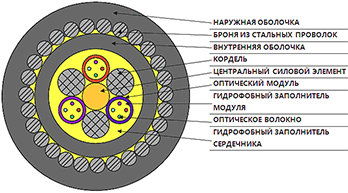 |
| GERDA-KOU-B | The cable is designed for installation in soils of groups 1-3, cable ducts, blocks, tunnels, collectors, inside buildings and structures. The number of optical fibers in the cable is up to 144. Resistance to static tensile forces – at least 2.5 kN. Resistance to compressive forces – at least 4.0 kN/100 mm. | 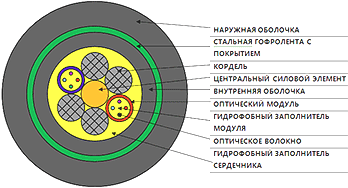 |
| GERDA-KOU-Kv | The cable is designed for suspension on overhead communication lines, in special pipes, tunnels, collectors, in conditions of an electric field. The number of optical fibers in the cable is up to 144. Resistance to static tensile forces – at least 3 kN. Resistance to compressive forces – at least 3.0 kN/100 mm. | 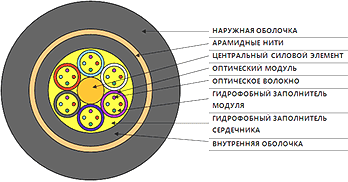 |
| GERDA-KOU-Tr | The cable is designed for suspension on communication line supports, city lighting lines, between buildings and structures, railway contact networks, and on power transmission line supports at points with a maximum electric field potential of up to 12 kV, on bridges and overpasses. The number of optical fibers in the cable is up to 144. Resistance to static tensile forces – at least 3.0 kN. Resistance to compressive forces – at least 3.0 kN/100 mm. | 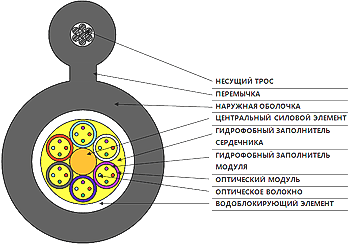 |
| GERDA-KOU-T | The cable is designed for indoor installation, use in local computer networks as a distribution optical cable. The number of optical fibers in the cable is up to 12. Resistance to static tensile forces – at least 1.0 kN. Resistance to compressive forces – at least 2.0 kN/100 mm. | 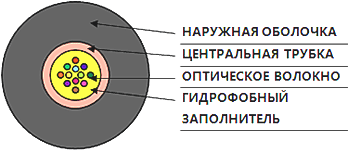 |
| GERDA-KOU-TK | The cable is designed for installation in soils of groups 1-3, cable ducts, tunnels, collectors, blocks, inside buildings and structures. The number of optical fibers in the cable is up to 12. Resistance to static tensile forces – at least 2.5 kN. Resistance to compressive forces – at least 3.0 kN/100 mm. | 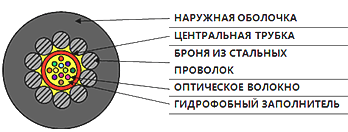 |
| GERDA-KOU-TTr | The cable is designed for suspension on communication line supports, railway contact networks, city lighting poles, between buildings and structures, on power transmission line supports at points with a maximum electric field potential of up to 12 kV, on bridges and overpasses. The number of optical fibers in the cable is up to 12. Resistance to static tensile forces – at least 3.0 kN. Resistance to compressive forces – at least 3.0 kN/100 mm. | 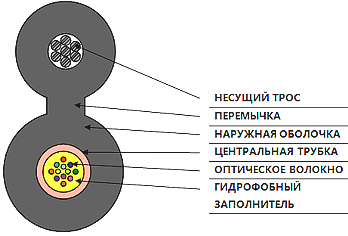 |
| Characteristic | Fiber type | |||||||
| MG1 | MG2 | E1 | E2 | E3 | E4 | E5 | ||
| 1. Mode field diameter, µm: | λ=1310 nm | – | – | 8.6-9.5 | – | – | – | – |
| λ=1550 nm | – | – | – | 9,5-13,0 | 8,6-9,5 | 7,8-8,5 | 8,0-11,0 | |
| 2. Cutoff wavelength in cable, λcc, nm | – | – | ≤ 1260 | ≤ 1530 | ≤ 1260 | ≤ 1260 | ≤ 1480 | |
| 3. Attenuation coefficient at reference wavelength, dB/km: | λ=850 nm | 2,4-3,5 | 2,8-3,5 | – | – | – | – | – |
| λ=1300 nm | ≤ 0,7 | ≤ 0,8 | – | – | – | – | – | |
| λ=1310 nm | – | – | ≤ 0,36 | – | – | – | – | |
| λ=1550 nm | – | – | ≤ 0,22 | ≤ 0,20 | ≤ 0,22 | ≤ 0,22 | ≤ 0,22 | |
| λ=1625 nm | – | – | – | – | ≤ 0,25 | – | ≤ 0,25 | |
| λ=1383 nm | – | – | ≤ 0,35 | – | – | – | – | |
| λ=1460 nm | – | – | – | – | ≤ 0,40 | – | – | |
| 4. Numerical aperture | 0,200 ±0,015 | 0,275 ±0,015 | – | – | – | – | – | |
| 5. Bandwidth coefficient, MHz·km | λ=1300 nm | ≥ 500 | ≥ 500 | – | – | – | – | – |
| 6. Chromatic dispersion coefficient, ps/nm·km: | λ=(1285-1330) nm | – | – | ≤ 3,5 | – | – | – | – |
| λ=(1525-1575) nm | – | – | ≤ 18 | ≤ 20 | – | ≤ 3,5 | – | |
| λ=(1530-1565) nm | – | – | – | – | 1,0-14,0 | – | ±(0,1-10,0) | |
| 7. Slope of the dispersion characteristic in the zero-dispersion wavelength region, ps/nm²·km: | λ= (1285-1330) nm | – | – | ≤ 0,093 | – | – | – | – |
| λ= (1525-1575) nm | – | – | – | ≤ 0,06 | – | ≤ 0,085 | – | |
| Optical fiber parameters | Fiber type | |||
| MG1 | MG2 | E1 | ||
| 1. Mode field diameter, µm: | λ=1310 nm | – | – | 9.2 ± 0.4 |
| λ=1550 nm | – | – | 10.4 | |
| 2. Cutoff wavelength in cable, λcc, nm | – | – | ≤ 1260 | |
| 3. Attenuation coefficient at reference wavelength, dB/km: | λ=850 nm | ≤ 3.5 | ≤ 3.5 | – |
| λ=1300 nm | ≤ 1.25 | ≤ 1.25 | – | |
| λ=1310 nm | – | – | ≤ 0.8 | |
| λ=1550 nm | – | – | ≤ 0.5 | |
| 4. Numerical aperture | 0.200 ±0.015 | 0.275 ±0.015 | – | |
| 5. Bandwidth coefficient, MHz·km | λ=850 nm | ≥ 400 | ≥ 160 | – |
| λ=1300 nm | ≥ 400 | ≥ 500 | – | |
| 6. Chromatic dispersion coefficient, ps/nm·km: | λ=(1285-1330) nm | – | – | ≤ 3.5 |
| λ=(1525-1575) nm | – | – | ≤ 18 | |
| 7. Slope of the dispersion characteristic in the zero-dispersion wavelength region, ps/nm²·km, max: | – | – | ≤ 0.092 | |
| Serial number of optical fiber or optical module | Color |
| 1 | Uncolored |
| 2 | Red |
| 3 | Yellow |
| 4 | Blue |
| 5 | Brown |
| 6 | Gray |
| 7 | Orange |
| 8 | Green |
| 9 | Black |
| 10 | Purple |
| 11 | Pink |
| 12 | Turquoise |
| Insulation and sheath material | Fire safety rating | Sheath material description | Operating temperature of the cable, °C |
| P | (no index) | polyethylene sheath | -40°…+60°C * |
| V | ng(A) | low-flammability PVC sheath | -50°…+70°C * |
| ng(A)-LS | low-smoke, low-gas-emission PVC sheath | -50°…+70°C * | |
| ng(A)-FRLS | low-smoke, low-gas-emission PVC sheath, fire-resistant cable | -50°…+70°C * | |
| ng(A)-HF | halogen-free polymer composite sheath | -50°…+70°C * | |
| ng(A)-FRHF | halogen-free polymer composite sheath, fire-resistant cable | -50°…+70°C * | |
| T | ng(A) | low-flammability thermoplastic elastomer sheath | -60°…+125°C |
| ng(A)-FR | low-flammability thermoplastic elastomer sheath, fire-resistant cable | -60°…+125°C | |
| * Cables can be manufactured in a cold-resistant version “HL” with an operating temperature from -60°C | |||
| Core type | |
| modular | |
| T | tubular |
| Sh | cord |
| Support wire | |
| no support wire | |
| Tr | presence of a support wire in the design |
| Armor type | |
| none | |
| K | steel wires |
| B | steel tapes |
| Kv | synthetic fibers |
| Ks | fiberglass rods |
| K2 | double-layer steel wires |
| B2 | double-layer steel tapes |
| Kv2 | double-layer synthetic fibers |
| Ks2 | double-layer fiberglass rods |
| Fire hazard rating |
| – |
| ng(A) |
| ng(A)-LS |
| ng(A)-HF |
| ng(A)-FRHF |
| Type of CSE | |
| no CSE (tubular) | |
| S | steel CSE |
| D | dielectric CSE |
| Supporting cable | |
| no supporting cable | |
| Tr | presence of a supporting cable in the design |
| Type of supporting cable | |
| no supporting cable | |
| c | steel |
| d | synthetic |
| Special characteristics | |
| P | polyethylene sheath |
| V | PVC plastic sheath |
| T | increased heat resistance |
| HL | frost-resistant (down to -60°) |
| DG | arc-resistant |
| M | oil-resistant |
| LТx | low toxicity |
| Number of elements in the strand, multiple elements are indicated with a hyphen | |
| 01, 04 – 12 | 01 – for a tubular core; from 04 to 12 for a modular core |
| v | water-blocking tape |
| a | alumoflex |
| – | for “Sh” design |
| Number of optical modules (OM) in the core strand | |
| 01…12 | specify the number of OM from 1 to 12 |
| for “Sh” design | |
| Permissible tensile load (kN): “0.4…80” |
| Conductive cores | |
| no cores | |
| M1-M10 | untinned from 1 to 10 |
| Ml1-Ml10 | tinned from 1 to 10 |
| Fiber coating | |
| no coating | |
| tb | tight buffer coating (900 µm) |
| Type of optical fiber (OF) | |
| E1 | standard single-mode |
| E2 | single-mode with minimized losses |
| E3 | single-mode with an additional transparency window |
| E4 | single-mode with shifted dispersion |
| E5 | single-mode with non-zero shifted dispersion |
| MG1 | multimode graded-index 50/125 µm |
| MG2 | multimode graded-index 62.5/125 µm |
| Number of optical fibers in the cable: “1…144” |
–
:
–
/
–
–
–
:
–
–
* — if different types of optical fibers (OF) are used in the cable, the quantities and types of all fibers are recorded using the “/” symbol. Example: 4E1/6E5/2MG1 – 4 standard single-mode OF, 6 single-mode OF with non-zero shifted dispersion, 2 multimode graded-index OF 50/125 µm.
| Examples of cable designation in orders | |
| GERDA-KOU-K-ng(A)-HF:C-07-06:048MG1-Ml1-7 TU 3587-020-76960731-2010 | Universal optical cable with a modular core, a steel central strength member (CSM), 7 stranded elements, 6 optical modules (OM), 1 tinned conductive insulated wire, 48 multimode gradient optical fibers (OF) 50/125 µm, steel wire armor, a halogen-free, flame-retardant sheath, with a tensile load of 7 kN |
| GERDA-KOU-B-ng(A)-FRHF:D-V-06/1.8(v)-03:24E1-3 TU 3587-020-76960731-2010 | Fire-resistant universal optical cable with a modular core, a dielectric central strength member (CSM), 6 stranded elements, 3 optical modules (OM), 24 standard single-mode optical fibers (OF), steel tape armor, a halogen-free, flame-retardant sheath, with a tensile load of 3 kN |
| GERDA-KOU-Sh-ng(A)-HF:V-4E1tb-1 TU 3587-020-76960731-2010 | Universal optical distribution cable with 4 standard optical fibers in tight buffer coating, a halogen-free, flame-retardant sheath, with a tensile load of 1 kN |
0 шт.
цена за шт. - 0 ₽
Error: Contact form not found.
Error: Contact form not found.